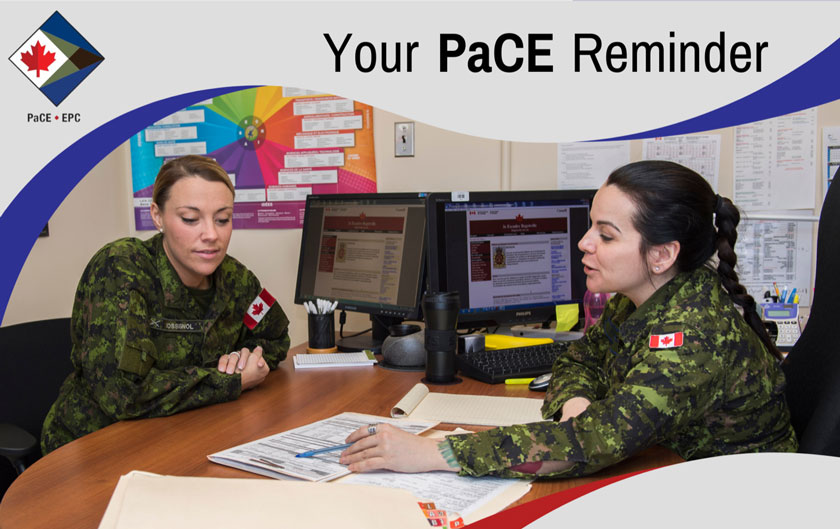Am I caught up with PaCE?
September 26, 2022 - Defence Stories

Caption
Two CAF members sit at a desk and review PaCE documents.
Canadian Armed Forces (CAF) members and Defence Team supervisors of CAF members, do you feel anxious or start to panic when you hear the word “pace” because you aren’t yet comfortable with the new Performance and Competency Evaluation (PaCE) system for CAF members?
First, don’t stress because it’s a natural feeling during the implementation year of a new system and you aren’t alone. Second, don’t forget that you have the power to eliminate this anxiety by becoming comfortable and confident on the new platform. As much as you may have been able to push “get caught up on PaCE” down your to-do list over the past year, CFPAS is gone, the time for postponement has well passed and it’s time to take control.
Remember that the CAF performance appraisal cycle covers a full year beginning on April 1 and ending on March 31. PaCE consists of four main components:
- The Job Description (JD);
- The Member Aspiration Profile (MAP);
- Feedback Notes (FN) (ongoing); and
- A Performance Appraisal Report (PAR).
Let’s check in. Now that the APS and summer-leave periods have drawn to a close, as a CAF member or a CAF member’s supervisor, what should you have already completed to date in PaCE? What should you be doing now?
We’ll start with an easy one: all PaCE written communications occur via MonitorMASS. If you do not have a profile and login credentials, obtain one without delay and familiarize yourself with the system.
Next, if you have not completed any PaCE training, verify with your chain of command (CoC) which courses on DLN 3.0 you are responsible to complete based on the PaCE roles you will hold, and initiate the training without delay.
CAF members, if you haven’t already, review your JD and build/review your MAP, including your opt-out options. Prepare for your MAP/JD interview with your supervisor. If you’ve already completed these steps, don’t forget to regularly create your own FNs summarizing the key tasks you have performed and their outcomes (remember that FNs not JDs detail your secondary duties). Generating FNs will be a practice you must carry out throughout the entire reporting year to ensure that your supervisor is aware of all of your good work. Make a note to produce FNs monthly or find a slightly different rhythm that works best for you and your supervisor. Continuously familiarize with the competencies and Behavioral Indicators (BIs) associated to your rank in order to develop and tailor your professional practices to meet them. And don’t forget that finding a strong mentor is always a great way to stay on track.
Supervisors, if you haven’t already, assign yourself in PaCE as supervisor to your CAF member(s) and review their MAP. Build/review and validate the JD with your CAF member and remember that you are the only one between the both of you who can “finalize” it officially. If it hasn’t been done yet, prepare for and conduct a MAP/JD interview with your CAF member and document this key debrief session using a FN (see examples in the MS Teams PaCE Knowledge Centre Channel 06 Wiki, link below). The aim is to fully understand their career goals and to foster the conditions for chain of command (CoC) support. Initiate discussions with your CoC and your CAF member’s career manager and BPSO as necessary to discuss what that support will look like.
Remember to discuss the opt-out option with your CAF member when you’re discussing their MAP. For CAF members to make an informed decision about Opting-Out, it is important that you both understand that a PAR will still be written to evaluate Performance, but that the member’s file will not be considered for Potential. Support your CAF member’s professional progression by regularly creating FNs for them, whether positive, corrective or developmental in substance. Acknowledge and respond to the FNs they submit to you. Remember that regular feedback is a powerful tool to guide behaviours, increase motivation, morale and work performance.
Finally, for supervisors, June 30 was the milestone for your first quarter FN debrief, and September 30 is the suggested deadline to conduct your second quarterly FN debrief session together. That means that you’ll need to have participated in multiple FNs prior to that date in order to have content in the system to discuss.
The MAP, JD and FNs are critical elements of the continuous feedback loop that PaCE is bringing front and center, and the quarterly debriefs will build on these over the course of the year. All this of course, culminates in the writing of the PAR. These all contribute to shaping each CAF member’s career progression.
Make a commitment to PaCE now to ensure you meet the Q3 (mid-December FN debrief) and Q4 (end of March FN debrief) deadlines. You don’t want to be se far behind that you cannot catch up, to both your own and CAF subordinates’ detriment.
Watch for subsequent articles this fall exploring in more depth some of more nuanced features of PaCE (ex “what is my CAF member deploys under another supervisor?”), and remember your resources: Performance and Competency Evaluation (PaCE) (forces.gc.ca), the MS Teams PaCE Knowledge Centre (access password: dkam7a7) (you are now leaving the Government of Canada website), and lastly, your own L1’s PaCE Directives that are more tailored to your organization.
Keep in pace with PaCE to cultivate the new mindset and skills required to modernize performance appraisal for all CAF members.
Page details
- Date modified: